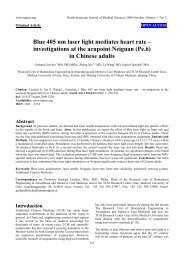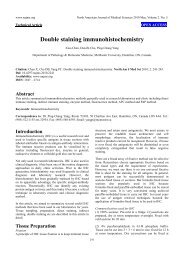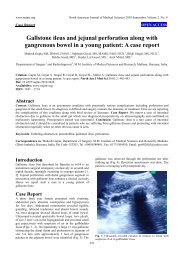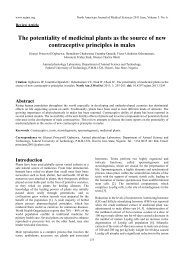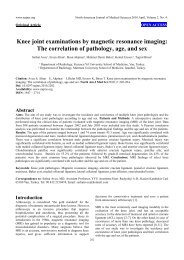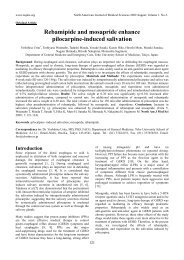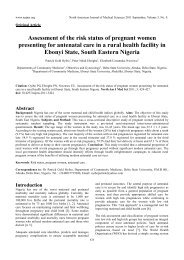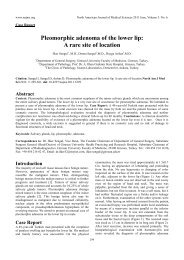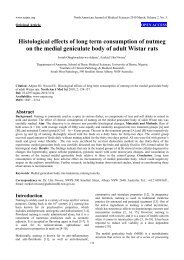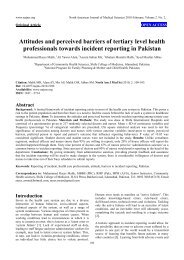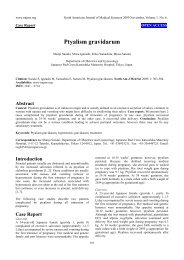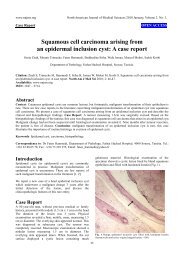Hepatotoxicity and nephrotoxicity evaluation in Wistar albino rats ...
Hepatotoxicity and nephrotoxicity evaluation in Wistar albino rats ...
Hepatotoxicity and nephrotoxicity evaluation in Wistar albino rats ...
You also want an ePaper? Increase the reach of your titles
YUMPU automatically turns print PDFs into web optimized ePapers that Google loves.
www.najms.org North American Journal of Medical Sciences 2010 May, Volume 2. No. 5.<br />
Orig<strong>in</strong>al Article OPEN ACCESS<br />
<strong>Hepatotoxicity</strong> <strong>and</strong> <strong>nephrotoxicity</strong> <strong>evaluation</strong> <strong>in</strong> <strong>Wistar</strong><br />
alb<strong>in</strong>o <strong>rats</strong> exposed to Mor<strong>in</strong>da lucida leaf extract<br />
Taofeeq Oduola 1 , Ibrahim Bello 2 , Ganiyu Adeosun 3 , Abdul-Waheed Ademosun 1 , Gassal Raheem 4 , Godw<strong>in</strong> Avwioro 5<br />
1 Departments of Hematology, 2 General Medical Practice, <strong>and</strong> 3 Chemical Pathology<br />
Obafemi Awolowo University Teach<strong>in</strong>g Hospital, Ile-Ife, Nigeria.<br />
4 Department of Chemical Pathology, Ladoke Ak<strong>in</strong>tola University of Technology Teach<strong>in</strong>g Hospital, Osogbo, Nigeria.<br />
5 Department of Anatomy <strong>and</strong> Cell Biology, Delta State University, Abraka, Nigeria.<br />
Citation: Oduola T, Bello I, Adeosun G, Abdul-Waheed A, Raheem G, Avwioro G. <strong>Hepatotoxicity</strong> <strong>and</strong> <strong>nephrotoxicity</strong><br />
<strong>evaluation</strong> <strong>in</strong> <strong>Wistar</strong> alb<strong>in</strong>o <strong>rats</strong> exposed to Mor<strong>in</strong>da lucida leaf extract. North Am J Med Sci 2010; 2: 230-233.<br />
Doi: 10.4297/najms.2010.2230<br />
Availability: www.najms.org<br />
ISSN: 1947 – 2714<br />
Abstract<br />
Background: Aqueous extract of Mor<strong>in</strong>da lucida benth leaf is consumed <strong>in</strong> Southern Nigeria <strong>in</strong> the treatment of malaria<br />
without any regard for its safety. Aim: The aim of the study was to <strong>in</strong>vestigate the effects of <strong>in</strong>gestion of the ethanolic leaf<br />
extract of the plant on liver <strong>and</strong> kidney functions <strong>in</strong> <strong>Wistar</strong> alb<strong>in</strong>o <strong>rats</strong>. Materials <strong>and</strong> Methods: Acute oral toxicity test<br />
was performed to determ<strong>in</strong>e the LD50; sub-chronic toxicity study was then carried out by oral adm<strong>in</strong>istration of different<br />
doses of the extract on daily basis to different groups of <strong>rats</strong> for 42 days. The animals were subsequently sacrificed, <strong>and</strong><br />
liver <strong>and</strong> kidney functions assessed biochemically us<strong>in</strong>g st<strong>and</strong>ard techniques. Results: The acute oral toxicity result, LD50,<br />
revealed Mor<strong>in</strong>da lucida leaf extract to be non-lethal at 6400mg/kg body weight. The results obta<strong>in</strong>ed for liver <strong>and</strong> kidney<br />
function parameters <strong>in</strong>dicated that <strong>in</strong>gestion of Mor<strong>in</strong>da lucida leaf extract has no toxic effect on liver <strong>and</strong> kidney functions.<br />
Conclusion: The results can form the basis for cl<strong>in</strong>ical trials <strong>in</strong> humans.<br />
Keywords: Mor<strong>in</strong>da lucida, leaf extract, liver, kidney, toxicity, <strong>rats</strong>.<br />
Correspondence to: Taofeeq Oduola, Department of Hematology, Obafemi Awolowo University Teach<strong>in</strong>g Hospital, Ile-<br />
Ife, Nigeria. Tel: 2348033968785. Email: oduolataofeeq@yahoo.com<br />
Introduction<br />
Plant derived products have been used for medic<strong>in</strong>al<br />
purposes for centuries. At present, it is estimated that<br />
about 80% of the world population relies on botanical<br />
preparations as medic<strong>in</strong>es to meet their health needs [1].<br />
Herbs <strong>and</strong> spices are generally considered safe <strong>and</strong> proved<br />
to be effective aga<strong>in</strong>st certa<strong>in</strong> ailments, while literature has<br />
documented severe toxic reactions from the use of herbs<br />
on many occasions, still the potential toxicity of herbs has<br />
not been recognized by the general public or by<br />
professional groups of traditional medic<strong>in</strong>e[2,3] Patients<br />
are often unaware of important similarities <strong>and</strong> differences<br />
between medic<strong>in</strong>al herbs <strong>and</strong> approved medications, some<br />
mistakenly th<strong>in</strong>k of herbs as natural alternative to<br />
chemicals, fail<strong>in</strong>g to recognize that herbs are composed of<br />
230<br />
bioactive chemicals some of which may be toxic [4].<br />
Many xenobiotics are capable of caus<strong>in</strong>g some degree of<br />
liver <strong>in</strong>jury [5]. The liver is prone to xenobiotic-<strong>in</strong>duced<br />
<strong>in</strong>jury because of its central role <strong>in</strong> xenobiotic metabolism,<br />
its portal location with<strong>in</strong> the circulation, <strong>and</strong> its anatomic<br />
<strong>and</strong> physiologic structure [6].<br />
The Kidney is highly susceptible to toxicants for two<br />
reasons. A high volume of blood flows through it <strong>and</strong> it<br />
filters large amounts of tox<strong>in</strong>s which can concentrate <strong>in</strong><br />
the kidney tubules. Nephrotoxicity is toxicity to the<br />
kidneys. It can result <strong>in</strong> systemic toxicity caus<strong>in</strong>g:<br />
decreased ability to excrete body wastes, <strong>in</strong>ability to<br />
ma<strong>in</strong>ta<strong>in</strong> body fluid <strong>and</strong> electrolyte balance <strong>and</strong> decreased
www.najms.org North American Journal of Medical Sciences 2010 May, Volume 2. No. 5.<br />
synthesis of essential hormones [7].<br />
Different parts of Mor<strong>in</strong>da lucida benth have been reported<br />
to possess medic<strong>in</strong>al properties. The leaf extract of the<br />
plant was reported to possess trypanocidal [8], antimalarial<br />
activities [9, 10] <strong>and</strong> aortic vasorelaxant effect [11].<br />
Oliver-Bever [12] documented the use of a weak decoction<br />
of the stem bark to treat severe jaundice. Mor<strong>in</strong>da lucida<br />
leaf extract has also been reported to have a strong oral<br />
hypoglycemic property [13, 14]; Adeneye <strong>and</strong> Agbaje [14]<br />
attributed this property to <strong>in</strong>creased peripheral utilization<br />
of glucose. The leaf extract of Mor<strong>in</strong>da lucida has also<br />
been documented to possess reversible antispermatogenic<br />
activities <strong>in</strong> <strong>rats</strong> [15].<br />
Many people <strong>in</strong> Southern Nigeria treat malaria by dr<strong>in</strong>k<strong>in</strong>g<br />
aqueous leaf extract of Mor<strong>in</strong>da lucida. It is well<br />
documented that Mor<strong>in</strong>da lucida leaf extract has various<br />
therapeutic benefits with no known adverse effect among<br />
the users; the responses of various organs; especially liver<br />
<strong>and</strong> kidney <strong>in</strong> humans, to <strong>in</strong>gestion of this extract rema<strong>in</strong><br />
largely unknown. Hence this study was undertaken to<br />
exam<strong>in</strong>e to what fashion liver <strong>and</strong> kidney function<br />
parameters would be affected <strong>in</strong> <strong>rats</strong> exposed to Mor<strong>in</strong>da<br />
lucida leaf extract.<br />
Materials <strong>and</strong> Methods<br />
Plant materials <strong>and</strong> preparation of plant extract<br />
The leaves of Mor<strong>in</strong>da lucida were collected <strong>in</strong> the month<br />
of June, 2009, at Tonkere, a village <strong>in</strong> Ile-Ife, Nigeria. The<br />
plant was authenticated at the herbarium of Botany<br />
Department, Obafemi Awolowo University, Ile- Ife, by Mr.<br />
Ademoriyo. The herbarium number is14650.<br />
The plants were collected, washed with tap water <strong>and</strong> cut<br />
<strong>in</strong>to t<strong>in</strong>y bits of about 2 cm. They were subsequently dried<br />
<strong>in</strong> a hot air oven <strong>and</strong> comm<strong>in</strong>uted us<strong>in</strong>g a gr<strong>in</strong>d<strong>in</strong>g<br />
mach<strong>in</strong>e. Four hundred <strong>and</strong> fifty grams of the ground<br />
sample was immersed <strong>in</strong> absolute ethanol for 72 hr on a<br />
mixer to ensure maximum extraction .The extract was<br />
filtered with a No 1 Whatman filter paper <strong>and</strong> the<br />
decoction was concentrated to dryness <strong>in</strong> vacuo on a rotary<br />
evaporator to obta<strong>in</strong> the crude ethanolic extract.<br />
Experimental animals<br />
Male <strong>and</strong> female Wister alb<strong>in</strong>o <strong>rats</strong> (200-260g) obta<strong>in</strong>ed<br />
from the animal house of the Faculty of Pharmacy,<br />
Obafemi Awolowo University, Ile-Ife were used for the<br />
study. They were housed <strong>in</strong> rat cages <strong>in</strong> well ventilated<br />
house, temperature of 27-30 0 C, 12 h natural light <strong>and</strong> 12 h<br />
darkness, with free access to tap water <strong>and</strong> dry rat pellet<br />
(purchased at Ogo Oluwa Enterprises, Ile-Ife). They were<br />
allowed to acclimatize for three days before the<br />
experiment.<br />
Acute oral toxicity study/LD50 determ<strong>in</strong>ation<br />
Different doses of the extract were adm<strong>in</strong>istered orally to<br />
seven groups of <strong>rats</strong> consist<strong>in</strong>g of 6 <strong>rats</strong> <strong>in</strong> a group. The<br />
animals <strong>in</strong> group A served as control <strong>and</strong> received normal<br />
231<br />
sal<strong>in</strong>e. The animals <strong>in</strong> groups B, C, D, E, F <strong>and</strong> H received<br />
200, 400, 800, 1600, 3200 <strong>and</strong> 6400mg/kg body weight<br />
respectively through oral adm<strong>in</strong>istration with a canula<br />
attached to a graduated syr<strong>in</strong>ge. They were all placed<br />
under observation for 24 h after which the numbers of<br />
dead <strong>rats</strong> were recorded, <strong>and</strong> LD50 calculated [16].<br />
Sub-chronic toxicity study<br />
None of the animals <strong>in</strong> the oral toxicity study died.<br />
Therefore, the extract was adm<strong>in</strong>istered to the animals for<br />
further 42 days. At the end of 42 days, the <strong>rats</strong> were<br />
weighed <strong>and</strong> blood samples collected through cardiac<br />
puncture under chloroform anesthesia <strong>in</strong>to lithium hepar<strong>in</strong><br />
specimen bottles for biochemical analysis. The animals<br />
were subsequently sacrificed by cervical dislocation. Liver<br />
<strong>and</strong> kidney function tests were performed on the blood<br />
samples us<strong>in</strong>g st<strong>and</strong>ard techniques [17].<br />
Statistical analysis<br />
The mean <strong>and</strong> st<strong>and</strong>ard deviation <strong>and</strong> the level of<br />
significance for the differences between means were<br />
computed by students test SPSS 6.<br />
Results<br />
In the acute oral toxicity study, no death was recorded<br />
even at the highest dose of 6400mg/kg body weight (Table<br />
1) an <strong>in</strong>dication that the LD50 of the plant is higher than<br />
6400mg/kg.<br />
The values of total <strong>and</strong> conjugated bilirub<strong>in</strong>s, total prote<strong>in</strong><br />
<strong>and</strong> album<strong>in</strong>, ALT, AST, <strong>and</strong> ALP obta<strong>in</strong>ed for the study<br />
groups (B, C, D, E, <strong>and</strong> F) showed no statistical significant<br />
differences (p>0.05) between the study <strong>and</strong> control<br />
animals (A). There were also no significant differences<br />
between the study groups (Table 2).<br />
In Table 3, there were no statistical significant differences<br />
(p>0.05) <strong>in</strong> the values obta<strong>in</strong>ed for Na + , K + , HCO − 3, Cl - ,<br />
urea <strong>and</strong> creat<strong>in</strong><strong>in</strong>e between the control <strong>and</strong> study groups,<br />
<strong>and</strong> between the study groups.<br />
Table 1 LD50 determ<strong>in</strong>ation by arithmetic method of Karbar<br />
adapted by Aliu <strong>and</strong> Nwude [16]<br />
Dose Rats Death Dose Mean Dose different<br />
(mg/kg)<br />
difference death X mean death<br />
Sal<strong>in</strong>e<br />
200<br />
400<br />
800<br />
1600<br />
3200<br />
6400<br />
6<br />
6<br />
6<br />
6<br />
6<br />
6<br />
6<br />
0<br />
0<br />
0<br />
0<br />
0<br />
0<br />
0<br />
-<br />
200<br />
400<br />
800<br />
1600<br />
3200<br />
-<br />
LD50 = Maximum dose = Y<br />
Number of <strong>rats</strong> per group<br />
-<br />
-<br />
-<br />
-<br />
-<br />
-<br />
-<br />
-<br />
-<br />
-<br />
-<br />
-<br />
-<br />
-
www.najms.org North American Journal of Medical Sciences 2010 May, Volume 2. No. 5.<br />
Table 2 Effect of <strong>in</strong>take of Mor<strong>in</strong>da Lucida aqueous extract on liver function profiles (N = 6)<br />
Parameters Group A Group B Group C Group D<br />
Control 200mg/kg 400mg/kg 800mg/kg<br />
Total Bilirub<strong>in</strong> (μmol/L) 12.67±3.50 10.83±1.84 12.00±2.37 11.88±2.14<br />
Conj Bilirub<strong>in</strong> (μmol/L) 4.33±1.03 3.83±1.17 3.67±1.21 3.50±1.38<br />
Total prote<strong>in</strong> (g/L)<br />
64.00±3.16 68.17±0.75 69.33±7.12 66.50±4.04<br />
Album<strong>in</strong> (g/L)<br />
37.83±2.32 39.17±1.47 38.67±4.37 40.00±3.45<br />
Globul<strong>in</strong> (g/L)<br />
ALT (IU/L)<br />
AST (IU/L)<br />
ALP (IU/L)<br />
26.17±3.25<br />
26.83±1.72<br />
20.83±1.47<br />
77.33±2.58<br />
27.00±1.79<br />
26.33±1.21<br />
21.17±1.47<br />
76.33±2.66<br />
28.67±3.39<br />
26.83±1.47<br />
20.83±1.47<br />
75.83±3.76<br />
27.95±2.14<br />
25.83±3.19<br />
21.00±2.10<br />
74.83±3.49<br />
Table 3 Effect of <strong>in</strong>take of Mor<strong>in</strong>da Lucida aqueous extract on kidney function profiles (N = 6)<br />
Parameters Group A Group B Group C Group D<br />
Control 200mg/kg 400mg/kg 800mg/kg<br />
Sodium (mmol/L) 137.17±6.24 136.33±5.68 137.17±2.79 134.00±3.74<br />
Potassium (mmol/L)<br />
Bicarbonate (mmol/L)<br />
Chloride (mmol/L)<br />
Urea (mmol/L)<br />
Creat<strong>in</strong><strong>in</strong>e (mmol/L)<br />
4.43±1.57<br />
25.33±2.16<br />
103.50±9.33<br />
6.40±1.01<br />
92.83±6.37<br />
4.42±0.45<br />
25.17±4.88<br />
104.33±9.59<br />
6.43±1.05<br />
92.17±15.09<br />
4.38±1.13<br />
24.83±3.31<br />
104.17±8.31<br />
6.27±0.85<br />
90.83±12.17<br />
4.40±1.47<br />
25.17±1.94<br />
105.17±4.71<br />
6.32±0.80<br />
92.83±8.47<br />
Discussion<br />
Investigation of the acute toxicity is the first step <strong>in</strong> the<br />
toxicological <strong>in</strong>vestigation of an unknown substance. The<br />
<strong>in</strong>dex of acute toxicity is the LD50. However, LD50<br />
should not be regarded as a biological constant, s<strong>in</strong>ce<br />
differ<strong>in</strong>g results are obta<strong>in</strong>ed on repetition or when the<br />
determ<strong>in</strong>ations are carried out <strong>in</strong> different laboratories [18],<br />
due to many variables such as animals’ species <strong>and</strong> stra<strong>in</strong>,<br />
age, gender, diet, bedd<strong>in</strong>g, ambient temperature, <strong>and</strong> time<br />
of the day. Hence, there are considerable uncerta<strong>in</strong>ties <strong>in</strong><br />
extrapolat<strong>in</strong>g LD50 value obta<strong>in</strong>ed for specie to other<br />
species, consequently, recogniz<strong>in</strong>g LD50 test as provid<strong>in</strong>g,<br />
at best, only a ballpark estimate of human lethality has<br />
been advocated [19].<br />
The result of acute oral toxicity (LD50) of Mor<strong>in</strong>da lucida<br />
leaf extract was found to be greater than 6400mg/kg body<br />
weight as no mortality was recorded <strong>in</strong> any group of<br />
experimental <strong>rats</strong>. In an acute oral toxicity study by<br />
Adeneye <strong>and</strong> Agbaje [14], Mor<strong>in</strong>da lucida leaf extract was<br />
documented to be non-lethal <strong>in</strong> <strong>rats</strong> at 2000mg/kg body<br />
weight.<br />
The current LD50 values based on acute oral toxicity<br />
recommended by the Globally Harmonized System of<br />
Classification <strong>and</strong> Label<strong>in</strong>g of Chemicals[20] are as<br />
follows: Category 1, ≤ 5mg/kg; category 2, ><br />
5mg/kg≤50mg/kg [they are both labeled as danger: fatal if<br />
swallowed]; category 3, >50mg/kg≤300mg/kg [danger:<br />
toxic if swallowed]; category 4, >300mg/kg ≤ 2000mg/kg<br />
[warn<strong>in</strong>g: harmful if swallowed], category 5,<br />
>2000mg/kg≤5000mg/kg [warn<strong>in</strong>g: may be harmful if<br />
swallowed] <strong>and</strong> LD50 >5000mg/kg [not classified: no<br />
specified label]. Hence, the LD50 of greater than<br />
6400mg/kg is an <strong>in</strong>dication that the extract may be safe for<br />
human consumption, confirm<strong>in</strong>g the belief of the<br />
herbalists that Mor<strong>in</strong>da lucida leaf extract is not harmful.<br />
The values obta<strong>in</strong>ed for liver function parameters showed<br />
232<br />
Group E<br />
1,600mg/kg<br />
10.67±1.75<br />
3.67±0.87<br />
67.17±5.25<br />
38.50±2.43<br />
29.67±1.17<br />
26.83±1.17<br />
21.00±2.37<br />
75.33±3.83<br />
Group E<br />
1,600mg/kg<br />
137.33±6.38<br />
4.30±0.96<br />
25.17±2.32<br />
101.00±9.49<br />
6.52±1.46<br />
93.00±7.24<br />
Group F<br />
3,200mg/kg<br />
10.17±3.37<br />
4.00±1.79<br />
65.33±4.68<br />
39.06±3.39<br />
26.83±3.76<br />
26.83±1.47<br />
20.83±2.32<br />
76.83±3.19<br />
Group F<br />
3,200mg/kg<br />
137.50±5.32<br />
4.43±0.88<br />
25.67±2.81<br />
103.83±10.63<br />
6.05±0.68<br />
93.67±10.27<br />
that the conjugat<strong>in</strong>g ability of the liver was not<br />
compromised from the total <strong>and</strong> conjugat<strong>in</strong>g bilirub<strong>in</strong><br />
levels; the synthetic ability of the liver was also<br />
ma<strong>in</strong>ta<strong>in</strong>ed judg<strong>in</strong>g from total prote<strong>in</strong> <strong>and</strong> album<strong>in</strong> values.<br />
There was also no hepatocellular damage as revealed by<br />
the ALT <strong>and</strong> AST values.<br />
The electrolytes, urea <strong>and</strong> creat<strong>in</strong><strong>in</strong>e are markers of kidney<br />
function, the plasma levels of these parameters <strong>in</strong> all<br />
groups of experimental animals <strong>and</strong> control were with<strong>in</strong><br />
reference range throughout the period of the study.<br />
In conclusion, from the present study, it was established<br />
that <strong>in</strong>gestion of Mor<strong>in</strong>da lucida leaf extract has no<br />
adverse effect on liver <strong>and</strong> kidney function <strong>in</strong> <strong>rats</strong>.<br />
Acknowledgement<br />
The authors are grateful to staff of animal house, Faculty<br />
of Pharmacy, Obafemi Awolowo University, Ile Ife, for the<br />
technical assistance rendered.<br />
References<br />
1. Shri JNM. G<strong>in</strong>ger: It’s Role <strong>in</strong> Xenobiotic<br />
Metabolism, ICMR Bullet<strong>in</strong> 2003; 33(6): 57-63.<br />
2. Deng JF. Cl<strong>in</strong>ical Toxicity of Herbal Medic<strong>in</strong>e <strong>in</strong><br />
Taiwan, 7 th International Conference on Health<br />
Problems Related to the Ch<strong>in</strong>ese. 1994<br />
3. O’Hara M, Kiefer D, Farrel K, Kemper K. A review<br />
of 12 commonly used medic<strong>in</strong>al herbs. Arch Fam Med<br />
1998; 523-536.<br />
4. Tyler VE. Herbs of Choice. The Therapeutic Use of<br />
Phytomedic<strong>in</strong>als, B<strong>in</strong>ghamton NY: Haworth Press Inc.<br />
1994<br />
5. Bass NM, Ockner BA. Drug-<strong>in</strong>duced liver disease, In:<br />
Zak<strong>in</strong> D, Boyer TD, eds. Hepatology: a textbook of<br />
liver disease, 3 rd eds. Philadelphia: WB Saunders,<br />
1996; 962-1017.
www.najms.org North American Journal of Medical Sciences 2010 May, Volume 2. No. 5.<br />
6. Jones AL. Anatomy of the normal liver. In: Zak<strong>in</strong> D,<br />
Boyer TD, Eds. Hepatology: a textbook of liver<br />
disease, 3 rd ed. Philadelphia: WB Saunders, 1996;<br />
3-32.<br />
7. Emily M. Toxicity. In: Encyclopedia of Earth. Eds.<br />
Cutler J. Clevel<strong>and</strong>, Wash<strong>in</strong>gton D.C. 2007<br />
8. Asuzu IU, Ch<strong>in</strong>eme CN. Effect of Mor<strong>in</strong>da lucida leaf<br />
extract on Trypanosoma brucei <strong>in</strong>fection <strong>in</strong> mice. J<br />
Ethnopharm 1990; 30(3): 307-312.<br />
9. Mak<strong>in</strong>de JM, Obih PO. Screen<strong>in</strong>g of Mor<strong>in</strong>da lucida<br />
leaf extract for malarial action on plasmodium berghei<br />
<strong>in</strong> mice. Afr J Med <strong>and</strong> Med Sc 1985; 14(1-2): 59-63.<br />
10. Tona L, Ngimbi NP, Tsakala M, Mesia K, Cimanga K,<br />
Apers, De Bruyne T, Pieters L, Totte J, Vliet<strong>in</strong>ck AJ.<br />
Antimalarial activity of 20 crude extract from n<strong>in</strong>e<br />
African medic<strong>in</strong>al plants used <strong>in</strong> K<strong>in</strong>shasha. Congo J<br />
Ethnopharm 1999; 68(1-3): 193-203.<br />
11. Ettarh RR, Emeka P. Mor<strong>in</strong>da lucida extract <strong>in</strong>duces<br />
endothelium-<strong>in</strong>dependent <strong>and</strong> <strong>in</strong>dependent relaxation<br />
of rat aorta. Fitoterapia 2004; 75(3-4): 332-336.<br />
12. Oliver-Bever B. Medic<strong>in</strong>al Plants <strong>in</strong> Tropical West<br />
Africa. Cambridge: Cambridge University Press, 1986;<br />
89-90.<br />
13. Olajide OA, Awe SO, Mak<strong>in</strong>de JM, Morebise O.<br />
Evaluation of the Anti-diabetic Property of Mor<strong>in</strong>da<br />
lucida Leaves <strong>in</strong> Streptozoc<strong>in</strong>-diabetic Rats J Pharm<br />
Pharmacology 1999; 51, (11): 1321-1324.<br />
233<br />
14. Adeneye AA, Agbaje EO. Pharmacological <strong>evaluation</strong><br />
of oral hypoglycemic <strong>and</strong> antidiabetic effects of fresh<br />
leaves ethanol extract of Mor<strong>in</strong>da lucida Benth <strong>in</strong><br />
normal <strong>and</strong> alloxan-<strong>in</strong>duced diabetic <strong>rats</strong>. Afr J<br />
Biomed Res 2008; 11(1): 65-71.<br />
15. Raji Y, Ak<strong>in</strong>somisoye OS, Salman TM.<br />
Antispermatogenic activity of Mor<strong>in</strong>da lucida extract<br />
<strong>in</strong> male <strong>rats</strong>. Asian J Androl 2005; 7(4): 405-410.<br />
16. Aliu YO, Nwude N. Veter<strong>in</strong>ary Pharmacology <strong>and</strong><br />
Toxicology Experiments, 1st Edition, ABU Press,<br />
1982; 104-110.<br />
17. Norbert WT. Textbook of Cl<strong>in</strong>ical Chemistry.<br />
Philadelphia, WB Saunders Company, 1986;<br />
1373-1430.<br />
18. Lorke D. A New Approach to Practical Acute Toxicity<br />
Test<strong>in</strong>g. Arch Toxicol 1983; 54: 275-287.<br />
19. Zb<strong>in</strong>den G, Flury-Roversi M. Significance of the LD50<br />
test for the toxicological <strong>evaluation</strong> of chemical<br />
substances. Arch Toxicol 1981; 4792: 77.<br />
20. L<strong>in</strong>k/URL: Globally Harmonized System of<br />
Classification <strong>and</strong> Label<strong>in</strong>g of Chemicals, 2003.<br />
(Accessed January 15<br />
)<br />
th , 2010<br />
at http://www.unece.org/trans/danger/publi/ghs/officia<br />
ltext.html



